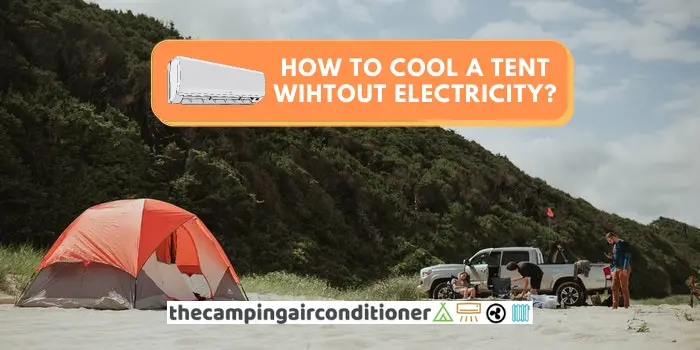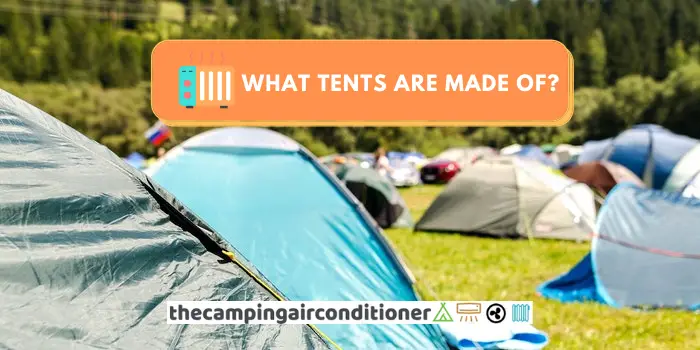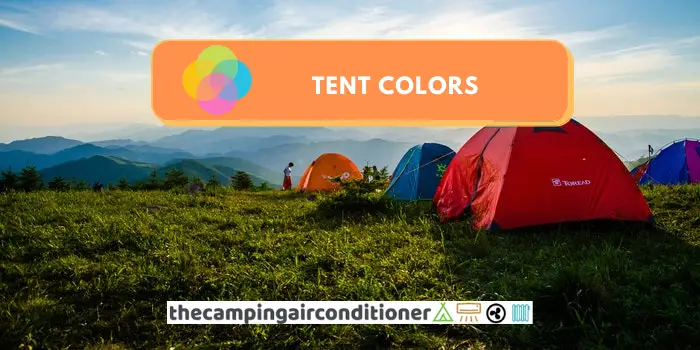We all have been in this situation – out of the blue, a wind load of more than 50km/h reach our campsite. Our tents start to shake or threaten to blow away – it becomes a little bit scary, and you might get worried about your safety and wellbeing!
So the natural question is: what are hacks for camping in windy conditions? We recommend a few measures, such:
a) Before arriving at the campsite
- Check the weather forecast for your camp.
- Choose a suitable tent
- Choose the adequate camping gear
- Consider using smaller tents.
- Don’t go camping by yourself
b) After arriving at the camping site
- Before pitching your tent, check the wind direction
- Ensure that the tent is adequately pegged
- If possible, set your tent up in a protected area
- Avoid using the rainfly (if possible)
c) In case of high winds
- Secure your campsite
- Consider opening tent windows
- Extinguish any campfire
- Stay calm and don’t panic
Let’s detail each of them to ensure that you are safe in case of a high wind load.
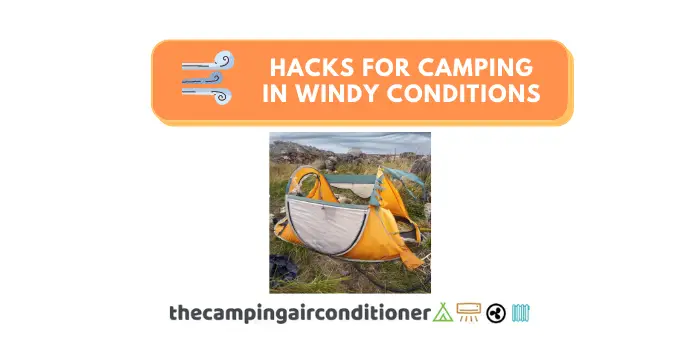
Tips for camping in windy conditions
Before arriving at the site
Tip 1 - Check the weather forecast
Regardless of the wind loads, you should always check the weather forecast before camping. It will help you plan your trip and what gear you should bring with you.
There are multiple sites available to check weather conditions. We usually use accuweather.com, as it is free and has generally given us accurate forecasts (they will all be wrong at some stage).
Tip 2 - Choose a suitable tent
Overall, you should not worry about wind loads below 20mph (32km/h) for most tents. These loads are considered standard, and your tent should handle them easily.
However, as wind loads increase above the 35km/h threshold, it is time to start thinking about stakes and pegs. If wind loads grow significantly above 65km/h, consider cancelling your trip or picking a special tent. These wind levels can blow away your tent.
Another crucial aspect here is tent shape. Overall, dome tents perform much better in windy conditions than cabin tents.
Their shape provides them with an optimal structure arrangement to support rainy and windy weather. The highest point is the centre, and the walls are inclined towards the ground. This shape significantly decreases the risk of your tent blowing away.
After thorough research, we recommend the MSR Hubba Hubba NX 2-Person model for high wind conditions.
Tip 3 - Consider smaller tents
The smaller the surface area exposed to the winds, the better. Smaller tents will naturally offer better aerodynamics to handle high wind loads.
Therefore, it might be good to review that extra space you always consider for comfort camping.
Overall, our rule is allowing for 20%-25% extra space for each camper – for example, if you are camping in 4, consider taking a 6-people tent. In this case, however, it is good to split into groups in windy conditions and have two campers in two different 2-people tents.
Tip 4 - Choose the adequate camping gear
Tip 5 - Don't go camping by yourself.
If possible, always bring a friend on board! Apart from making the trip funnier and more pleasant, it might be a good idea to have an extra pair of hands to hold the tent down!
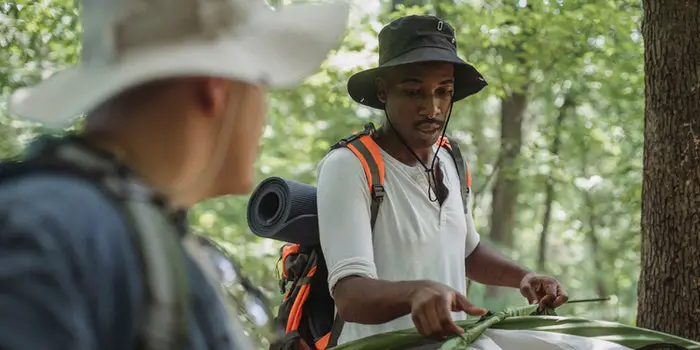
After arriving at the campsite
Tip 6 - Check the wind direction
Understand where the wind blows typically and use your basic knowledge of aerodynamics to pitch your tent.
Avoid pitching the lateral of your tent perpendicular to the direction that the wind blows. The laterals usually comprise the tent’s most extensive area and don’t want it facing the airflow.
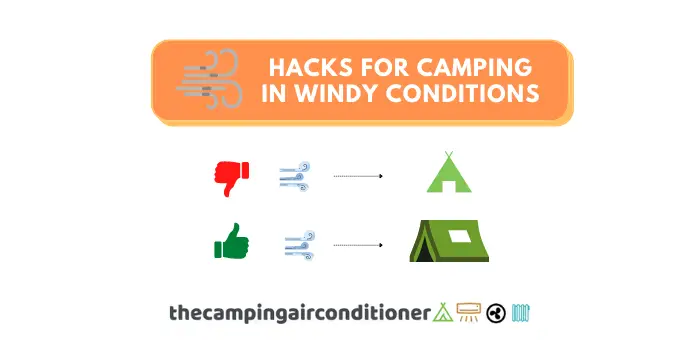
Tip 7 - Ensure the tent is adequately pegged and fixed to the ground.
If winds are going above 20mph, you should consider using stakes and pegs. They will be crucial to maintaining the tent’s stability in windy conditions.
Check for the tent’s manufacturer instructions on fixing the pegs and stakes. Each shelter has different design specs, and optimal safety might be obtained with different configurations.
Make sure that you pound your pegs and stakes on the ground with the correct angle. Overall, we recommend using a 45 degrees position, but check instructions from the tent’s manufacturer.
Further, if you are camping for a couple of nights, play on the safe side and check the status of ropes, stakes, and pegs daily. Never let them get loose.
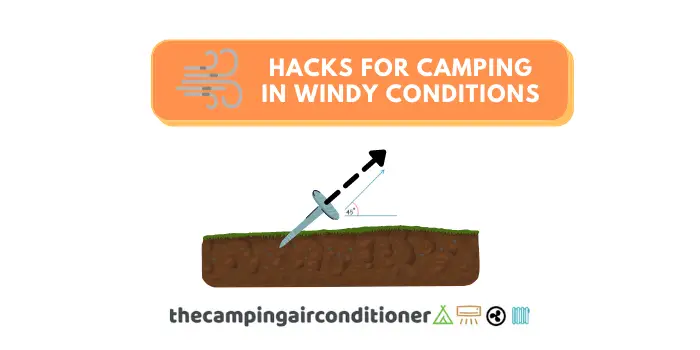
Tip 8 - Set up your tent in a protected area
Always look for natural windbreaks, such as threes, and structures in the campsite. You can even use your car as a windbreaker in the worst-case scenario. Avoid pitching your tent on top of the hills or open areas since this will significantly increase wind exposure.
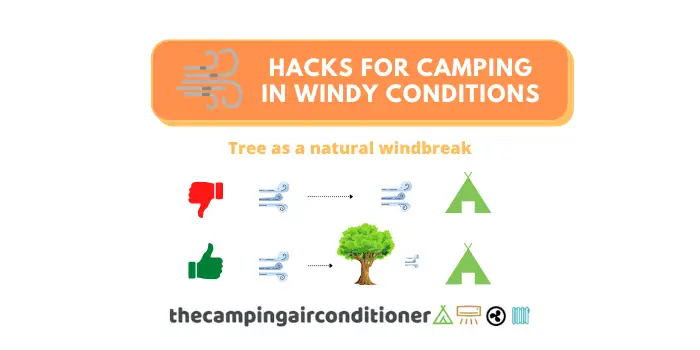
Tip 9 - Avoid using the rainfly
If the weather forecast indicates no rain, there is no reason to use the rain fly bit. It will cause aerodynamic drag and increase blowing away risks in high wind loads.
In case of high winds
Tip 10 - Secure your campsite
In case you notice high winds are coming in your tent’s direction, do the following:
- Double-check how stiff are pegs, stakes, and guy ropes
- Relocate all your camping gear, personal belongings, and accessories inside the tent.
- Retract or remove awnings
- Remove you rainfly
- If you have any electric equipment connected to power, it might be worth disconnecting them
- Turn off your tent heater.
Tip 11 - Consider opening tent windows
As detailed in tip 6, you can facilitate the airflow and reduce aerodynamics drag by opening your tent windows so that tent’s walls creates less wind resistance. The rationale is that wind will go through your tent without carrying it away.
Tip 12 - Extinguish any campfire
As detailed in how hot is a campfire article, the more oxygen available, the longer, more burning and more flames you will have in a campfire.
Things can get out of control during windy conditions, and the fire can spread very quickly. Hence, it is prudent to extinguish it straightaway. Make sure that you drown it with water, and there is no chance for reignition.
Tip 13 - Stay calm
Panicking will never help. Keep calm and make sure you put in place all the previous tips. By doing that, your chances of having your tent blown away are minimal.
If you are anxious and nervous, take a deep breath and relax. Things will come down at some stage. If anxiety feelings do not stop, protect yourself in your car.
FAQ
How much wind can a tent withstand?
This will vary according to each tent, if you use pegs and stakes or not, soil conditions and many other factors. Overall, we can classify wind speeds in the following categories:
- Less than 20mph (32km/h) – This is considered a light wind condition, and the majority of tents should be able to support this load without much trouble
- Between 20mph and 40mph (32hm/h and 65km/h) – This is considered an intense wind load, and you should consider using tents stakes and pegs.
- Above 50mph (65km/h) – This is considered a dangerous wind load and if you intend camping in these conditions, make sure that you have the proper gear.
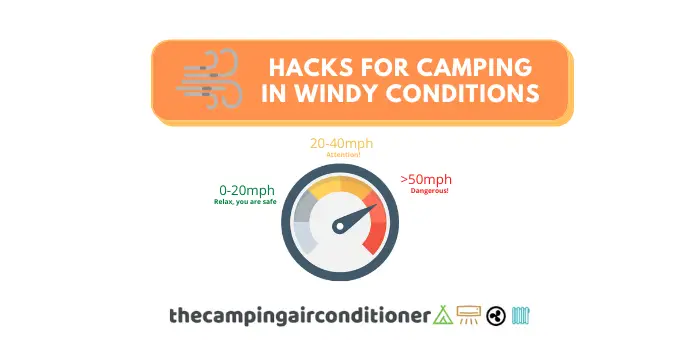
Are there tents for high wind loads?
Yes, there are. You should take into consideration multiple factors to choose it, such as tent weight, tent’s size, height, and shape, poles, and stakes.
After a quick research, we recommend the following model – MSR Hubba Hubba NX 2-Person. This dome-shaped tent has silicone poles specifically designed to support fierce winds.
What is the best tent shape for windy conditions?
Dome tents will perform better than cabin tents in windy conditions. This is because of their natural shape and intrinsic aerodynamics features.
What is the best tent material for windy conditions?
Each tent material will come with its advantages and drawbacks. Overall:
- Canvas tents are more robust and heavier and tend to be used in bigger tents, therefore not ideal for windy conditions.
- Nylon and Polyester tents are very similar, with nylon having a higher strength-to-weight ratio. Both materials are commonly used for dome tents because of their lightweight characteristics.
Ultimately, we believe that tent shape is much more important than the fabric used to manufacture it.
Conclusion
We hope these tips come in handy and are helpful for your next trip. Never forget – the secret to a successful journey is planning!
Give special attention to tips before arriving at the campsite to ensure you are prepared in case of a wind storm.





